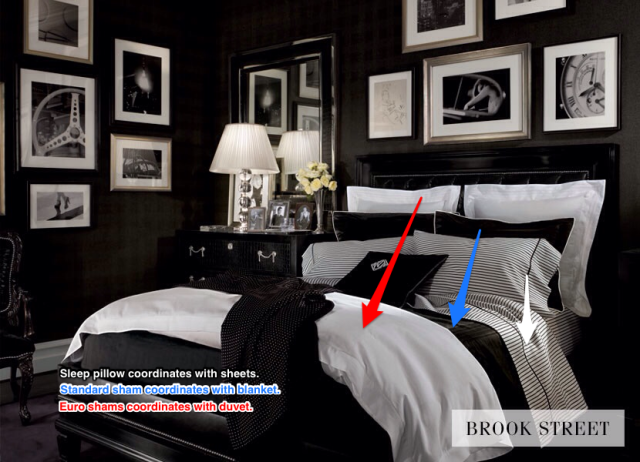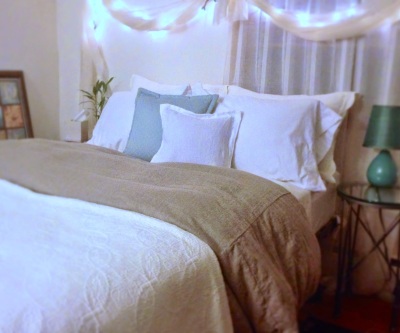The infamous pottery barn bed…doesn’t it make you feel relaxed? But, no “real” beds look like this, right? Guess what – with just a few tricks and tips, your bed CAN look professionally-designed.
One day I decided my bed needed a make-over and began researching how to “make my bed look good”. Soon I came across this bit of advice from Tricia Rose of Rough Linen:
“Virtually any bed looks beautiful if it has a woman lying naked in it, on her side, seen from behind, with a sheet carelessly draped across her bottom.”
…Interesting, but unfortunately for me that’s not sustainable. So I kept researching. The more I learned, the more I realized how applying a few tidbits of knowledge can make a big difference. At the end of this post I’ll show you how I transformed my sad old bed into something awesome.
1) Perfect beds have solid foundations.
 |
| This coordinating bedskirt contributes to a neat, tailored look. |
 |
| A white or ivory bedskirt is versatile. Ruffles impart a whimsical or feminine flair. |
 |
| A Saatva Mattress, which is affordable, eco-friendly, and sold online. |
Mattress topper (memory foam or featherbed). This gives your mattress extra plushness and helps achieve that “wanna-dive-in-right-now!” look that showroom beds have. Some mattresses come with a padded pillowtop layer sewn-in, which sounds great unless the material starts to compress and break down before the rest of the mattress wears out. The solution? Get a non-pillowtop mattress (or one with a thin pillowtop layer) and add a featherbed or memory foam topper based on what feels best to you. A topper can also add comfort to an older mattress or increase the lifespan of a new one.
Secret 2) Thread count isn’t all that matters.
Pima (Supima) and Egyptian are long staple varieties of cotton, meaning they’ll be softer, wear better, and less likely to pill than inferior, short-staple cotton (often denoted by sheets labeled as just “cotton”). Avoid sheets that are mostly or all polyester – this manmade fiber won’t absorb moisture or breathe as well as natural ones, leaving you feeling clammy.
Pure linen is a prized material for bed sheets, and sheets made of linen can last a lifetime unlike those made of other textiles. Linen is temperature regulating, strong, absorbent, and environmentally-friendly (click to learn more). High-quality linen feels soft yet textured and gets even better with age. Linen’s reputation for excessive wrinkling is much undeserved. Sheets made of bamboo fibers can also be very comfortable, boasting high breathability like linen but with a silkier hand initially.
 |
| Pure linen sheets and duvet cover from Rough Linen |
If you choose cotton sheets, which are the most popular and accessible, there are several weave types that will impact how the sheets feel. Sateen weave gives the fabric smoothness and luster. A percale weave produces a matte finish and helps keep you cool.
Secret 3) Know your bedspread options
 |
| Textured rouching on this bedspread is elegant and romantic |
The showstopper for many beds is the bedspread. A bedspread generally refers to all bed coverings, especially those that extend past the mattress and even down to the floor. A comforter has a layer of thick padding sewn inside a decorative cover, which cannot be removed. A duvet is meant to be used inside a duvet cover, which is like a giant pillowcase and can be removed for washing by undoing the buttons or ties at one end. The duvet is usually filled with down (fluffy under-feathers from geese or ducks) or synthetic filling, although other materials may be used.
 |
| Rustic duvet from Rough Linen |
Quilts are another option for a bedspread, providing medium warmth and a classic look. Quilts have a layer of batting in between two layers of fabric, whereas coverlets are usually only 1 layer and non-reversible. In summer or hot climates, a coverlet or lightweight cotton blanket may be all that is needed.
 |
| The bold, contemporary look of this quilt is softened by a timeless ruffled bedskirt. |
Secret 4) High fill power down
To get that really plush look that characterizes magazine-worthy beds, you should invest in a down comforter. Down is graded based on fill power, which relates to its loftiness or ability to trap air. Higher fill power down takes up more space per ounce, trapping more air and making it extremely light, lofty, and warm. For example, 800 fill power down will keep you warmer and look much fluffier than the same amount of 600 fill power down. While the weight of the down (number ounces in the comforter) determines how warm it is, fill power determines its lightness and loftiness. High fill power down is also more durable, as the down clusters are larger and more robust to breakage. Click here to learn more about down.
Secret 5) Use a bolster
A bolster is a cylinder-shaped cushion that fills the awful space between the mattress and headboard where the pillows sink down. It props up your pillows, gives you a firm support for laying back against, and the best part is you just wedge it in and forget about it!
 |
Secret 6) It’s all in the accent
 Accent pillows in complementary colors weave together the look of the bed and set the focal point. A bold or funky piece that stands out but fits in with the overall look of the bed or bedroom as a whole will add dimension and interest. Accent pillows come in a variety of shapes and sizes and are a fun way to personalize your bed and experiment with different textures and patterns. They also come in handy for providing extra back or neck support while reading in bed.
Accent pillows in complementary colors weave together the look of the bed and set the focal point. A bold or funky piece that stands out but fits in with the overall look of the bed or bedroom as a whole will add dimension and interest. Accent pillows come in a variety of shapes and sizes and are a fun way to personalize your bed and experiment with different textures and patterns. They also come in handy for providing extra back or neck support while reading in bed.  |
| Click here for more ideas for arranging pillows |
Secret 7) Beds have layers









Great post full of useful tips! My site is fairly new and I am also having a hard time getting my readers to leave comments. Analytics shows they are coming to the site but I have a feeling “nobody wants to be first”.
consumer reports mattresses
LikeLike